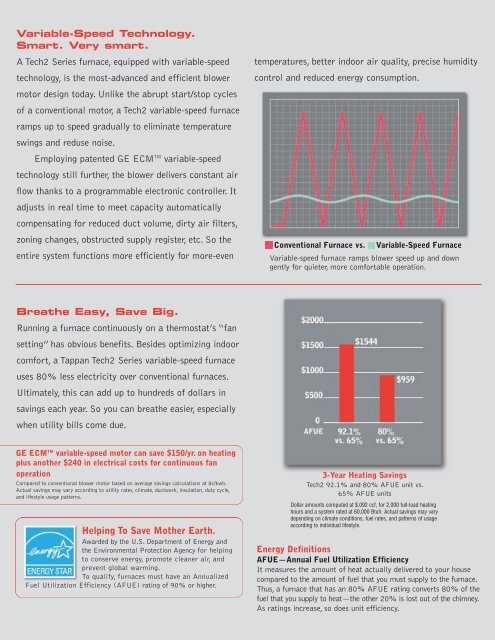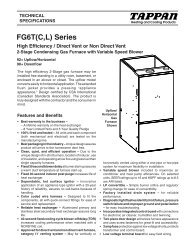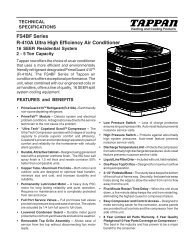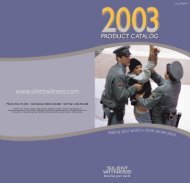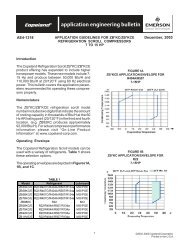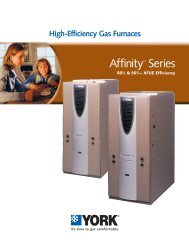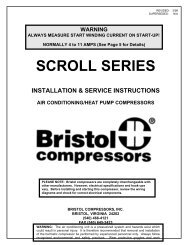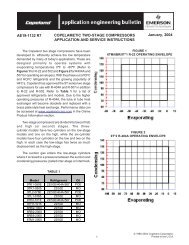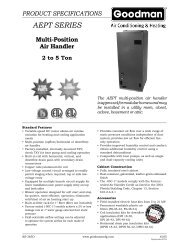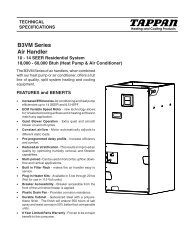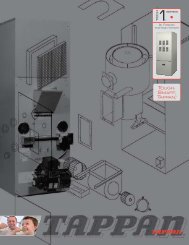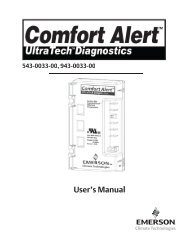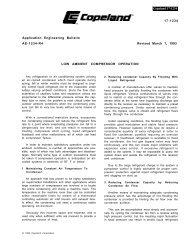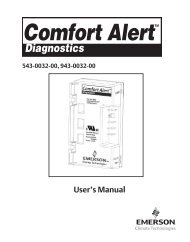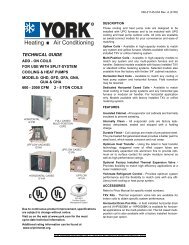Tappan Single Stage Gas Furnaces - Desco Energy
Tappan Single Stage Gas Furnaces - Desco Energy
Tappan Single Stage Gas Furnaces - Desco Energy
You also want an ePaper? Increase the reach of your titles
YUMPU automatically turns print PDFs into web optimized ePapers that Google loves.
Variable-Speed Technology.<br />
Smart. Very smart.<br />
A Tech2 Series furnace, equipped with variable-speed<br />
technology, is the most-advanced and efficient blower<br />
motor design today. Unlike the abrupt start/stop cycles<br />
of a conventional motor, a Tech2 variable-speed furnace<br />
ramps up to speed gradually to eliminate temperature<br />
swings and reduse noise.<br />
Employing patented GE ECM TM variable-speed<br />
technology still further, the blower delivers constant air<br />
flow thanks to a programmable electronic controller. It<br />
adjusts in real time to meet capacity automatically<br />
compensating for reduced duct volume, dirty air filters,<br />
zoning changes, obstructed supply register, etc. So the<br />
entire system functions more efficiently for more-even<br />
temperatures, better indoor air quality, precise humidity<br />
control and reduced energy consumption.<br />
Conventional Furnace vs. Variable-Speed Furnace<br />
Variable-speed furnace ramps blower speed up and down<br />
gently for quieter, more comfortable operation.<br />
Breathe Easy, Save Big.<br />
Running a furnace continuously on a thermostat’s “fan<br />
setting” has obvious benefits. Besides optimizing indoor<br />
comfort, a <strong>Tappan</strong> Tech2 Series variable-speed furnace<br />
uses 80% less electricity over conventional furnaces.<br />
Ultimately, this can add up to hundreds of dollars in<br />
savings each year. So you can breathe easier, especially<br />
when utility bills come due.<br />
GE ECM TM variable-speed motor can save $150/yr. on heating<br />
plus another $240 in electrical costs for continuous fan<br />
operation<br />
Compared to conventional blower motor based on average savings calculations at 8c/kwh.<br />
Actual savings may vary according to utility rates, climate, ductwork, insulation, duty cycle,<br />
and lifestyle usage patterns.<br />
Helping To Save Mother Earth.<br />
Awarded by the U.S. Department of <strong>Energy</strong> and<br />
the Environmental Protection Agency for helping<br />
to conserve energy, promote cleaner air, and<br />
prevent global warming.<br />
To qualify, furnaces must have an Annualized<br />
Fuel Utilization Efficiency (AFUE) rating of 90% or higher.<br />
3-Year Heating Savings<br />
Tech2 92.1% and 80% AFUE unit vs.<br />
65% AFUE units<br />
Dollar amounts computed at $.092 ccf, for 2,000 full-load heating<br />
hours and a system rated at 60,000 Btuh. Actual savings may vary<br />
depending on climate conditions, fuel rates, and patterns of usage<br />
according to individual lifestyle.<br />
<strong>Energy</strong> Definitions<br />
AFUE—Annual Fuel Utilization Efficiency<br />
It measures the amount of heat actually delivered to your house<br />
compared to the amount of fuel that you must supply to the furnace.<br />
Thus, a furnace that has an 80% AFUE rating converts 80% of the<br />
fuel that you supply to heat—the other 20% is lost out of the chimney.<br />
As ratings increase, so does unit efficiency.


